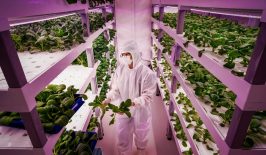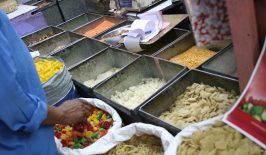When strict coronavirus restrictions were introduced throughout the country, Indian farmers’ crops began rotting in the fields. But thanks to the innovative use of social media, they’re connecting directly with their end consumers – and finding a way out of the crisis.
In response to the coronavirus emergency, the Indian government imposed one of the strictest lockdowns seen in a large nation – especially for one so densely populated. For city dwellers, the restrictions on social distancing meant many were confined to their homes and unable to freely move around their neighbourhoods, and for rural farmers the coronavirus rules had another important impact.
The restrictions meant farmers were severely limited in their abilities to source labour, transport goods and sell to wholesalers, resulting in thousands of tons of produce potentially going to waste, unpicked, on their fields and farms. According to the Vegetables Growers Association of India, around 30 percent of Indian produce has gone to waste during the coronavirus lockdown, much more than the usual 5 to 10 percent than can be expected in a year.
Small and marginal farmers have been particularly impacted, as these often lack access to refrigeration units to store their produce, while many had also taken out loans in order to pay for seeds and finance the year’s growing. What’s more, they traditionally relied on wholesalers to purchase their crops and then transport them onto shops and markets. With the wholesalers barred from visiting farms, their crops were quickly going to waste. Even in cases when wholesalers could arrive, the need for famers to quickly sell their produce meant they were in a poor position to negotiate and wholesale buyers could offer extremely low prices.
Many smaller farmers had also abandoned traditional cash crops, or crops that could be stored without refrigeration, in favour of more lucrative fruits, such as pineapple, watermelons and mangoes, which are in higher demand in more affluent urban centres. These crops in particular are those most at risk from either over-ripening or rotting.
From Farm to Fork – via Twitter and Facebook
To help alleviate the problem, Indian farmers began to turn to the power of social media to help them move their produce. Through platforms such as Twitter and Facebook, smaller farmers have been able to advertise and sell their produce directly to consumers – something which previously could only occur through a middleman. For example, when agri-finance entrepreneur Ruchit Garg saw produce being discarded at the side of the road, he realised he could use his pre-existing networks to connect small farmers directly with their customers. He told The Indian Express:
“Small farmers have difficulty accessing markets, feeds and fertilisers, machinery and financial loans and insurances. I have access to a network of 10,000,000 farmers across 22 states. During the lockdown, I saw farmers struggling and throwing away crops. Farmers didn’t know how to connect with buyers.”
He created the Harvesting Farmers Network, and although the system is still relatively grassroots, it generally works like this: A farmer creates a post stating their location, contact details and the amount and type of produce they have. Individual buyers – whether they be a store or individual – can make contact with them and arrange transportation of the goods. Within some housing complexes, consumers have also been creating WhatsApp groups to develop bulk purchases, allowing the farmers to maximise on the amount sold.
Elsewhere, for example on the Facebook group lovelocalbuylocal, social media users have been taking part in ‘challenges’ to promote the sale of specific crops, such as pineapple. Users can post recipes and pictures of their pineapple-based dishes which can then be linked to a farmer selling that crop for a good price.
Furthermore, some farmers have discovered that by cutting out the middleman, a better deal can be negotiated for both the farmer and the consumer, especially restaurants. In fact, although the social media networks developed in response to an emergency, some are looking at them as potentially a long term supply option. Ashish Kumar, who runs a food business in Ghaziabad told Mongabay:
“I am in the restaurant business. It makes sense for me to have better supply chain options. Also, we all talk about supporting farmers. So, such a model can be a win-win situation for everyone.”
An Imperfect Solution
There are, however, teething issues to the solution. Firstly, it is only really open and viable to farmers in general proximity to an urban centre. In reality, many farmers are in relatively isolated rural regions and cannot source the transport to move goods long distances. Also, even though the state has lifted some lockdown restrictions on the transport of crops from farms to cities, transporting goods between states is still difficult, as a driver can only enter a city every two weeks due to quarantine restrictions.
Connecting farmers with end consumers may also not always be the most profitable solution for farmers, as consumers generally only want a small amount of crops per sale. To make it worth the while to transport the goods, large bulk orders are required, which are rarer when dealing through these social media platforms.
Additionally, the grassroots nature of these Twitter and Facebook pages means they are often susceptible to dishonesty – whether that is farmers posting inaccurate images of their produce, or buyers renegotiating a much lower price once the goods arrive. The lack of official oversight and the interpersonal nature of the transactions means any wronged party often has little recourse to compensation. Some platforms hope to reduce the risk of this by creating rules and regulations within their platforms as well as a rating system for buyers and sellers.Ultimately, these relatively ad hoc social media accounts could be replaced with more bespoke and permanent platforms if the idea is to continue post-coronavirus. In any case, it could also be having an additional positive effect, by reminding urban consumers about the origins of their food and the challenges faced by India’s smaller farmers and encouraging them to see the things they eat in a different light. The same effect has been created by marketplace innovations in Europe. One example is the website Crowdfarming that connects farmers and food lovers – letting them log on to adopt your own personal tree, beehive, vine, plant, or even sheep and receive their produce when harvest comes around. Let’s hope these positive effects continue – even after the lockdown is over.






